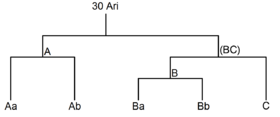| Revision as of 19:38, 29 December 2020 editLithopsian (talk | contribs)Autopatrolled, Extended confirmed users, New page reviewers68,720 edits fix references← Previous edit | Revision as of 19:40, 29 December 2020 edit undoLithopsian (talk | contribs)Autopatrolled, Extended confirmed users, New page reviewers68,720 edits remove stub tagsNext edit → | ||
| Line 157: | Line 157: | ||
| ] | ] | ||
| ] | ] | ||
| {{Multi-star-stub}} | |||
| {{extrasolar-planet-stub}} | |||
Revision as of 19:40, 29 December 2020
 | |
| Observation data Epoch J2000 Equinox J2000 | |
|---|---|
| Constellation | Aries |
| 30 Arietis A | |
| Right ascension | 02 37 00.5235 |
| Declination | +24° 38′ 49.9880″ |
| 30 Arietis B | |
| Right ascension | 02 36 57.7449 |
| Declination | +24° 38′ 53.0026″ |
| Astrometry | |
| 30 Arietis A | |
| Proper motion (μ) | RA: 136.862±0.137 mas/yr Dec.: −15.188±0.141 mas/yr |
| Parallax (π) | 22.1261 ± 0.0726 mas |
| Distance | 147.4 ± 0.5 ly (45.2 ± 0.1 pc) |
| 30 Arietis B | |
| Proper motion (μ) | RA: 141.411±0.083 mas/yr Dec.: −10.677±0.086 mas/yr |
| Parallax (π) | 22.3641 ± 0.0516 mas |
| Distance | 145.8 ± 0.3 ly (44.7 ± 0.1 pc) |
| Orbit | |
| Primary | 30 Arietis A |
| Companion | 30 Arietis BC |
| Period (P) | 34000 yr |
| Semi-major axis (a) | 40" (1670 AU) |
| Orbit | |
| Primary | 30 Arietis B |
| Companion | 30 Arietis C |
| Period (P) | 80 yr |
| Semi-major axis (a) | 22.3 AU |
| Characteristics | |
| Spectral type | F5 V / F6 V |
| B−V color index | 0.410 / 0.510 |
| Details | |
| 30 Arietis A | |
| Mass | 1.31 ± 0.04 M☉ |
| Radius | 1.37 ± 0.03 R☉ |
| 30 Arietis Ba | |
| Mass | 1.16 ± 0.04 M☉ |
| Radius | 1.13 ± 0.03 R☉ |
| Other designations | |
| CCDM 02370+2439, WDS 02370+2439 30 Arietis A BD+24°375, HD 16232, HIP 12184, HR 764, SAO 75470 | |
| Database references | |
| SIMBAD | data |
| Exoplanet Archive | data |
| Data sources: | |
| Hipparcos Catalogue, CCDM (2002), Bright Star Catalogue (5th rev. ed.) | |
30 Arietis (abbreviated 30 Ari) is a 6th-apparent-magnitude quadruple star in the constellation of Aries. 30 Arietis is the Flamsteed designation. 30 Arietis A and B are separated by 38.1" or about 1500 AU at a distance of 130 light years away. The main components of both systems are both binaries with a composite spectra belonging to F-type main-sequence stars, meaning they are fusing hydrogen in their cores. 30 Arietis A is itself a spectroscopic binary with an orbital period of 1.1 days. The 30 Arietis system is 910 million years old, one fifth the age of the Sun.
Planetary system
On November 27, 2009, the discovery of a very massive planet was announced to be orbiting 30 Arietis B at a distance of about 1 AU. In 2020, after the inclination of the planetary orbit was measured, the "planet" was found to fall in the mass range of the red dwarf star.
References
- ^ Brown, A. G. A.; et al. (Gaia collaboration) (August 2018). "Gaia Data Release 2: Summary of the contents and survey properties". Astronomy & Astrophysics. 616. A1. arXiv:1804.09365. Bibcode:2018A&A...616A...1G. doi:10.1051/0004-6361/201833051. Gaia DR2 record for this source at VizieR.
- ^ Brown, A. G. A.; et al. (Gaia collaboration) (August 2018). "Gaia Data Release 2: Summary of the contents and survey properties". Astronomy & Astrophysics. 616. A1. arXiv:1804.09365. Bibcode:2018A&A...616A...1G. doi:10.1051/0004-6361/201833051. Gaia DR2 record for this source at VizieR.
- ^ Whitney Clavin (2015). "Planet 'Reared' by Four Parent Stars | NASA". NASA. Retrieved 4 March 2015.
- ^ Roberts Jr, Lewis C.; Tokovinin, Andrei; Mason, Brian D.; Riddle, Reed L.; Hartkopf, William I.; Law, Nicholas M.; Baranec, Christoph (2015), "Know the Star, Know the Planet. III. Discovery of Late-Type Companions to Two Exoplanet Host Stars", The Astronomical Journal, 149 (4): 118, arXiv:1503.01211, Bibcode:2015AJ....149..118R, doi:10.1088/0004-6256/149/4/118, S2CID 30908636
- ^ Guenther, E. W.; et al. (2009). "A substellar component orbiting the F-star 30 Arietis B". Astronomy and Astrophysics. 507 (3): 1659–1665. arXiv:0912.4619. Bibcode:2009A&A...507.1659G. doi:10.1051/0004-6361/200912112.
- Morbey, C. L.; Brosterhus, E. B. (1974). "A Search for Spectroscopic Binaries from Published Radial Velocity Data". Publications of the Astronomical Society of the Pacific. 86 (512): 455. Bibcode:1974PASP...86..455M. doi:10.1086/129630. JSTOR 40675565.
- Kiefer, Flavien; Hébrard, Guillaume; Lecavelier, Alain; Martioli, Eder; Dalal, Shweta; Vidal-Madjar, Alfred (2020), Determining the true mass of radial-velocity exoplanets with Gaia 9 planet candidates in the brown-dwarf/stellar regime and 27 confirmed planets, arXiv:2009.14164
External links
| Constellation of Aries | |||||||||||||
|---|---|---|---|---|---|---|---|---|---|---|---|---|---|
| Stars |
| ||||||||||||
| |||||||||||||
| Galaxies |
| ||||||||||||
| |||||||||||||
| |||||||||||||